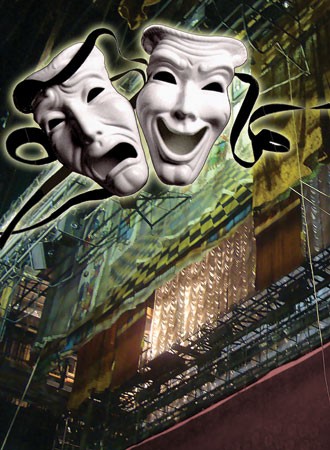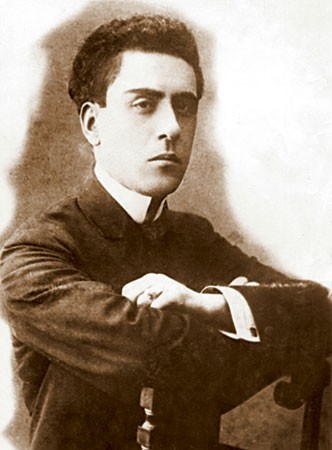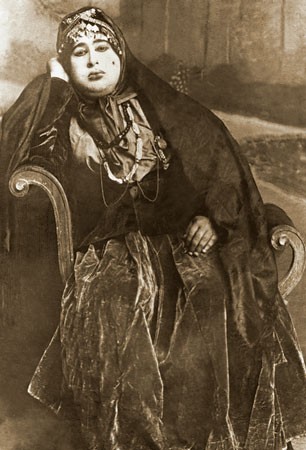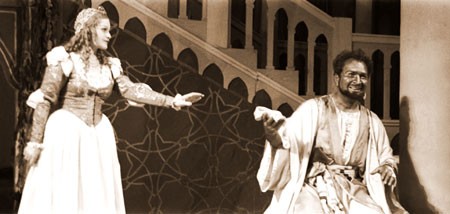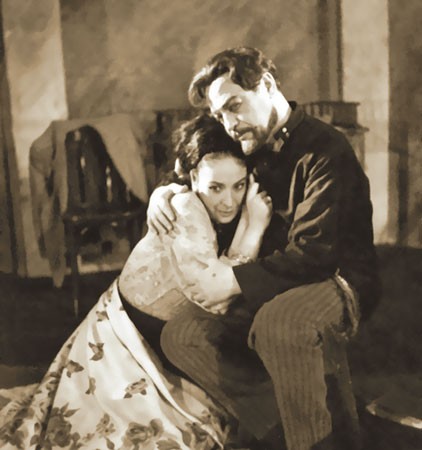Theatre Day, shaping the nation
After a lapse of 20 years following the creation of a dramaturgy that could be classified as “national” by its artistic and aesthetic parameters, if not by its form, a group of Azerbaijani intellectuals prepared an amateur performance of the comedy “The Adventures of the Vizier of the Khan of Lenkaran” by Mirzah Fatali Akhund-Zadeh. This was on the eve of the Novruz Bayram holiday. The 20th March is celebrated in the Republic as National Theatre Day and the date that a European-type theatre appeared here. In 1883, the first permanent establishment known locally as “the Taghiyev Theatre” opened in Baku. This was a period of large-scale development in the oil industry, the shaping of the national bourgeoisie and increasing economic interest from the West (England, Norway and Germany) and Russia in this eastern city. Naturally, this interest was accompanied by most of the cultural accoutrements of European civilisation to Baku.“In order to shape a nation, first its theatre must be established”. At the end of the 19th century, Goethe’s theory seemed to be under test within local time and space, by Azerbaijani educators (H.Zardabi, N.Vazirov, A,Gorani). They wanted to establish that the presence of theatre in the national culture was an important condition for shaping a nation. However, they imported the model of western theatre which was imitated in Russia, in other words, they brought an imitation of an imitation to Baku. Further, they had not considered the fact that many of the Muslim population in Baku would treat the requirements of “making theatre” - shaving off men’s moustaches and powdering their faces, wearing women’s clothes and acting as women onstage - with disgust, and that they would prevent women from being involved in this branch of the arts.
Notwithstanding all these obstacles, interest in the theatre increased rapidly. The heroes of Shakespeare, Schiller, Heinrich Heine, Moliere, Gogol and Tolstoy began to speak in the Azerbaijani Turkic language and local writers (N.Narimanov, A.Hagverdiyev, J.Mammadgulu-Zadeh) penned plays on different topics, trying to match the world-renowned playwrights. Troupes of amateur actors appeared in Baku and other regions of Azerbaijan (Nakhchivan, Shusha). The core of these troupes of actors were volunteers (H.Arablinsky, A.M.Sharif-Zadeh, M.A.Aliyev, S.Ruhulla and others) who acted as various saints in the religious mystery plays (historically they are defined as “mystery theatre”). Female roles were acted by foreign women who could speak the Azerbaijani language or men wearing women’s clothes and make-up (A.Agdamsky, A.Suheyli and others). That was a period of generation and organisation of the Azerbaijani Theatre. I call the theatre of this period the “THEATRE OF PRIMITIVE INTUITION”.
Primitive to passionate....
From 1873 until the 1920s, the Azerbaijani theatre was the theatre of emotional projects from intellectuals aligned with strong romantic passions - the “THEATRE OF HOT-TEMPERED HEROES” - created by a few daring amateurs from a combination of rough severity and shy naturalism; this theatre perceived itself wholly as a reflection of educational ideas. From 1887-1920 there was considerable activity in the organisation of Azerbaijani theatre: troupes of professional actors consisted of Muslims from various cultural and educational communities (“Nijat”, “Sefa”) and staged numerous plays, shaping the first version of a national theatre ethos. Finally, 46 years from the date of the first performance, in October 1919, the Democratic Republic of Azerbaijan announced the opening of the State Theatre.From1920, following the incursion of the Bolshevik Red Army into Azerbaijan, a process began of dynamic sovietisation of the European-type theatre. The years from 1920 to 1990 are defined as a period of Sovietisation, monumentalism, dissension and democratisation. The number of theatres in Baku increased rapidly in a short period: along with the State Theatre (now the National Theatre) and the Theatre of Opera and Ballet, the Russian Drama Theatre and the Baku Turkic Labour Theatre joined the national theatre process. In spite of the number and condition of theatres in the republic, the image and the artistic and aesthetic parameters of the official theatre in Azerbaijani theatre culture was always defined by the National Theatre (which has been known by different names over the years). The Azerbaijani Theatre experience from 1920-1938 was characterised as a stage of self-expression.
The theatre of that period was a tribune for outbursts of passion, emotions, fiery speeches and humane ideas. It was a pure ACTOR’S THEATRE, a theatre of pathos and pomposity, of individuals, tragic conflicts and melodramatic feelings. In this period, when directors were changed very often, repertoires were based upon plays in the style of philosophical parables, unhappy tales of fate, folk anecdotes and the world’s classics (W. Shakespeare, V. Hugo, H. Hauptman, F. Schiller, J.B. Moliere, M. Gorky, N. Gogol etc.) While theatre was trying to establish its creative image and line, the political and ideological repression being carried out in the USSR soon removed the people (H.Javid, A.M. Sharif-Zadeh, Ulvi Rajab) responsible for developmental tendencies in Azerbaijani theatre culture and thus sent the process of self-identification in a completely different direction.
.... to politics and pomp
Thus the transformation of the National Theatre under the management of chief director Adil Isgenderov; Soviet dramaturgy (including young local Soviet writers) took precedence in the theatre repertoire for its political and ideological subjects. On the other hand Isgenderov became the author, if we can put it like that, of the BAROQUE stage: he did not revise the national theatre’s artistic and aesthetic parameters: on the contrary, he increased the weight of the sublime, darkened the colours and included hot-blooded passions and startling declamations, achieving a synthesis of heroic folk dramas (for example, Samed Vurgun’s “Vagif” or “Farhad and Shirin”, plays written in verse) with festive splendour and luxury, turning their characters into theatrical giants, poet-cyclops possessing enormous voices and power. Thus, theatre became a beautiful, living MYTH. History remembers the National Theatre under Isgenderov’s management as a theatre of salient expression, statuesque postures, cultured and regal manners, graceful beauties, fascinating ladies and bronzed heroes, as well as the THEATRE OF RHYTHM AND HARMONY, a theatre of loud, melodic voices and emotional speeches. The play “Vagif” (S.Vurgun), a heroic folk drama genre staged in 1938, and the play “Othello” (W. Shakespeare) interpreted in 1949 as a crisis of faith by Adil Isgenderov, earned the status of symbols of national theatre culture and artistic standards: successes and spectators swarmed to the theatre like bees to honeycombs. Isgenderov’s ethos and monumentally heroic theatre, with its festive overtones, was also viewed as a THEATRE OF ACTORS: people made Alesger Alekberov (Vagif, Othello), Sidgi Ruhulla (Gajar), Barat Shekinskaya (Desdemona, Mirandolina), Hokuma Gurbanova (Olivia, Shirin), Mirza Agha Aliyev (Sir Toby, Osip) and Mohsun Sanani (Malcolm, Cavaliere Ripafratta, Scapin) their idol, their prophets; they deified them and turned them into legends. For the Azerbaijani theatre, Alesger Alekberov was the equivalent of Laurence Olivier for the English theatre. There was a notable similarity between Barat Shekinskaya and Vivienne Leigh. This meant that the National Theatre of the time could easily go on tour. However, every theatrical fashion has a life of 5 to 10 years. After that a period of search and change becomes necessary. So the National Theatre reached the threshold of the 1960s with petrified policy, a pile of template expressions and hackneyed themes; there was a clear need for radical reform.Back to earth
The National (Drama) Theatre located in the old Taghiyev theatre, after being given the title “Academic”, was moved into a new building on Fuzuli square. The stagnation at the theatre resulted in Isgenderov’s dismissal and director Mehdi Mammadov (“Twelfth Night”, “Young Guard”, “Dance Teacher”, “Hotel Hostess” etc.) was charged with managing the theatre. Mehdi Mammadov who was an apologist for the philosophical extravagance of the theatre, did not dare change the artistic and aesthetic content and, upset by the intrigues typical of theatre, soon left the position. At this time the theatre needed a head director who could open the doors and windows of Isgenderov’s “sealed monumental edifice” to the values of modern theatre culture. The extrovert and impulsive Tofig Kazimov who adopted a strongly dissident position towards the social and political regime and did not accept Isgenderov’s theatre policies, was the only person capable of such a task, so he was assigned to the position of chief director of the National Theatre. If Isgenderov’s theatre model was a compressed version of Stalinist society, then Kazimov’s theatre has to be seen as a reflection of the ‘thaw’ in the USSR’s social and political priorities. Kazimov entered national theatre history as a reformer of the Azerbaijani stage: he turned the National Theatre into the THEATRE OF THE CONCEPTUAL DIRECTOR. Declaring that the director was the true creator of a performance, he approached plays as texts giving the general contours of a stage work. He wanted an end to the vices of the theatre of educators, release from the crass, theatrical speeches, the pathos and pomposity of Isgenderov’s theatre; he wanted to interweave political and ideological conflict with existential conflict and to bring theatre closer to ordinary people’s experience. There was no connection between the theatrical ideas of Tofig Kazimov with Brecht’s “political theatre”, and its epic theories. He rejected the existing templates, the old instruments of expression and the sublime and emotional manner of performance left over from the theatre of educators. He would replace the grandeur, artificial festivity and statuesque posing with sincerity of experience and communicative gesture and manner on the stage of the National Theatre (the M. Azizbeyov State Academic Dramatic Theatre of Azerbaijan). He worked to bring to the stage an ordinary manner of speech, domestic psychology and the poetry of inner thoughts and intimate relations.Moreover, he changed the balance of forces in favour of young actors, including plays by representatives of the new dramaturgy (I. Efendiyev, I.Gasimov, R.Ibrahimbeyov). Tofig Kazimov’s actors, namely Hasan Turabov, Amaliya Panahova, Shafiga Mammadova, Samandar Rzayev, Hamlet Khani-Zadeh and Fuad Poladov, were to go on to shape the destiny of Azerbaijani theatre. His productions like “Sen hemishe menimlesen” (“You are always with me”) (1964), “Oluler” (“Deadmen”) (1966) and “Firtina” (“Storm”) (1974) are recognised as symbols of a true revolution and new theatrical thinking in their approach to the rules of theatre in Azerbaijan. However, this process was not continuous or lasting: he was confronted by numerous obstacles (social, public and intra-theatre intrigues) he was overcome with pessimism and could not implement his own theatre programme. His reforms seemed to vanish suddenly from the theatre and attempts were made to return to the theatre regime of the 1930s-50s.
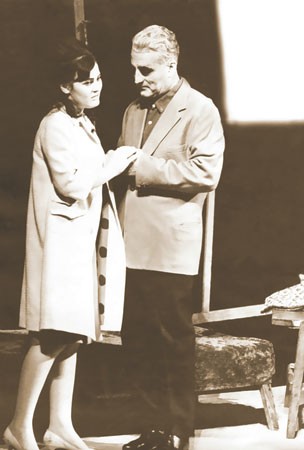 Amaliya Panahova as Nargile, Ali Zeynalov as Hasanzade, in You Are Always With Me by I.Efendiyev (1964)
Amaliya Panahova as Nargile, Ali Zeynalov as Hasanzade, in You Are Always With Me by I.Efendiyev (1964)
Reform
However, by the end of the 1970s and the beginning of the 1980s, a new generation of directors, including Huseynaga Atakishiyev, Vagif Ibrahimoglu and Azerpasha Nemat were already trying to radically change attitudes towards the conception of a “national theatre” from outside the confines of the National Theatre; they to deconstruct theatrical practice. In the 1980s there was some democratisation in the theatre world of Azerbaijan. In fact, at that time theatre’s public status fell into noticeable decline, it was confined to the periphery. Thus, the efforts of the above-mentioned directors remained local initiatives. Although each of them had a complete conception of theatre, they did not influence a broad audience. The play “The Career of Arturo Ui” (1981), staged by Atakishiyev, was a hit at a German festival devoted to Bertolt Brecht’s dramaturgy. Nemat’s production “The School in Danabash Village” (1983) made a big impact on theatre society. The plays “Greetings from Heydarbaba” (1990) and “the Son” (1990) employed a completely different theatre aesthetic for national theatre culture. Today, Ibrahimoglu’s “Yugh State Theatre”, which has worked on a synthesis of vanguard European theatre and the traditions of national theatre, cannot break out of the theatre-laboratory. Atakishiyev died and his principles of theatre have been forgotten. Azerpasha Nemat is president of the Union of Theatre Workers, and is also a director: he stages plays only rarely, depending on his mood. However, it would be unfair to say that these directors have not had any influence on national theatre culture as a whole.The play “Bulbul” (Nightingale) (1989) staged by Namig Agayev, director of the State Puppet Theatre of Azerbaijan, was repeatedly awarded the highest prizes at the world’s most prestigious festivals in the interval between 1990 and 2000, in other words during the early period of independence.
The puppet performance of “Arshin Mal Alan”, staged by director Tarlan Gorchu, has been around for approximately 30 years and its tours of cities in America and Europe always end in calls of “bravo”. The State Pantomime Theatre, established in 1994, is one of the most successful theatres of our times. This theatre communicates regularly with various other theatres in the world and receives countless invitations from foreign countries. The relatively youthful “Uns” creativity centre supports cinema, theatre and music in general, follows the world’s interesting artistic events and organises visits by world-famous artists to Baku. The production centre “PRO-CENT” pursues the same aims and organises theatrical enterprises. Of course, these are the positives and pleasant aspects of Azerbaijani theatre culture. We note that all of them lie outside the National Theatre, in other words, the centrifugal forces apparent in social and political life are also characteristic of theatre culture, although the small number of examples may constitute the exceptions that prove the rule. The government of Azerbaijan would not wish to entrust the future of our theatre to exceptions and chance and desires a better and more stable life for theatre. Thus, reforms to Azerbaijani theatre are inevitable.
